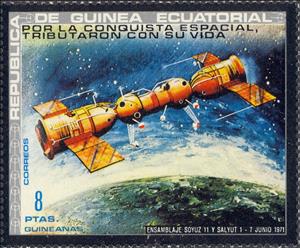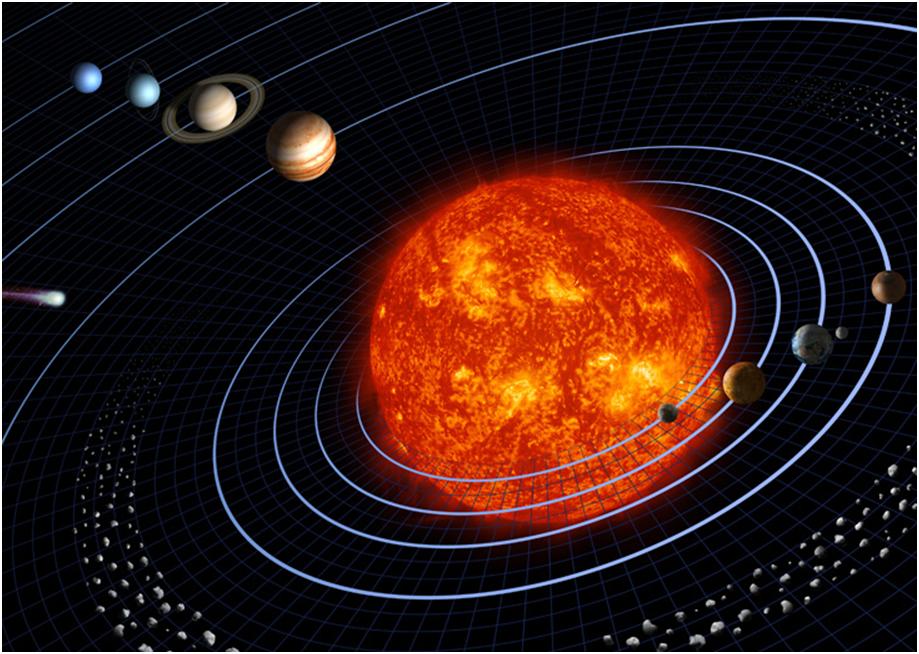Stamp: Soyuz 11 and Salut 1 (Equatorial Guinea 1972)
Soyuz 11 and Salut 1 (Equatorial Guinea 1972)
14 December (Equatorial Guinea ) within release By the conquest of space goes into circulation Stamp Soyuz 11 and Salut 1 face value 8 Equatorial Guinean peseta
| Stamp Soyuz 11 and Salut 1 in catalogues | |
|---|---|
| Michel: | Mi:GQ 193 |
| Yvert et Tellier: | Yt:GQ 26D |
Stamp is horizontal format.
Also in the issue By the conquest of space:
- Souvenir Sheet - Komarov, Volkov, Dobrovolsky, Patsayev, Grissom, White, Chaf face value 250+50;
- Stamp - Grissom, White and Chaffee face value 1;
- Stamp - Vladimir Komarov face value 3;
- Stamp - Soyuz 11 face value 5;
- Stamp - Soyuz 11 and Salut 1 face value 8;
- Stamp - V. Volkov, G. Dobrovolsky, V, Patsayev face value 10;
- Stamp - The incident face value 15;
- Stamp - The dead cosmonauts face value 25;
- Souvenir Sheet - P.Volkov, Dobrovolsky, Patsaev face value 200+25;
- Stamp - P.Volkov, Dobrovolsky, Patsaev face value 200+25;
- Stamp - Komarov, Volkov, Dobrovolsky, Patsayev, Grissom, White, Chaf face value 250+50;
- Stamp - Grissom, White and Chaffee face value 1;
- Stamp - Soyuz 11 face value 5;
- Stamp - Soyuz 11 and Salut 1 face value 8;
- Stamp - The dead cosmonauts face value 25;
- Stamp - The incident face value 15;
- Stamp - V. Volkov, G. Dobrovolsky, V, Patsayev face value 10;
- Stamp - Vladimir Komarov face value 3;
Stamp Soyuz 11 and Salut 1 it reflects the thematic directions:
Celestial bodies or heavenly bodies are objects in space such as the sun, moon, planets, and stars. They form a part of the vast universe we live in and are usually very far from us.
A spacecraft is a vehicle that is designed to fly and operate in outer space. Spacecraft are used for a variety of purposes, including communications, Earth observation, meteorology, navigation, space colonization, planetary exploration, and transportation of humans and cargo. All spacecraft except single-stage-to-orbit vehicles cannot get into space on their own, and require a launch vehicle (carrier rocket).
An astronaut (from the Ancient Greek ἄστρον (astron), meaning 'star', and ναύτης (nautes), meaning 'sailor') is a person trained, equipped, and deployed by a human spaceflight program to serve as a commander or crew member aboard a spacecraft. Although generally reserved for professional space travelers, the term is sometimes applied to anyone who travels into space, including scientists, politicians, journalists, and tourists
Outer space (or simply space) is the expanse that exists beyond Earth's atmosphere and between celestial bodies. It contains ultra-low levels of particle densities, constituting a near-perfect vacuum of predominantly hydrogen and helium plasma, permeated by electromagnetic radiation, cosmic rays, neutrinos, magnetic fields and dust. The baseline temperature of outer space, as set by the background radiation from the Big Bang, is 2.7 kelvins (−270 °C; −455 °F)





